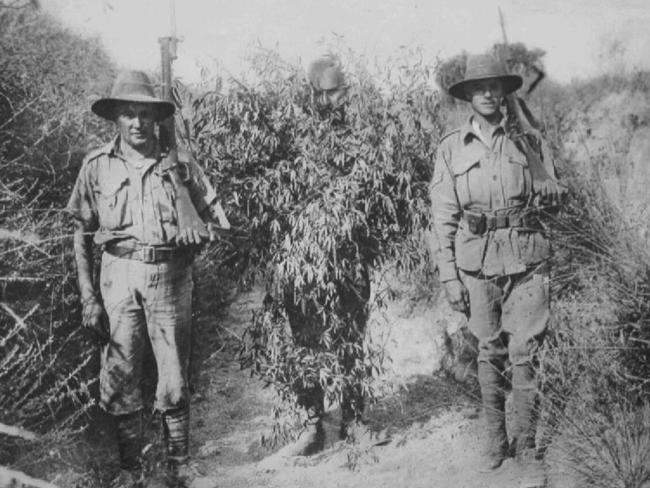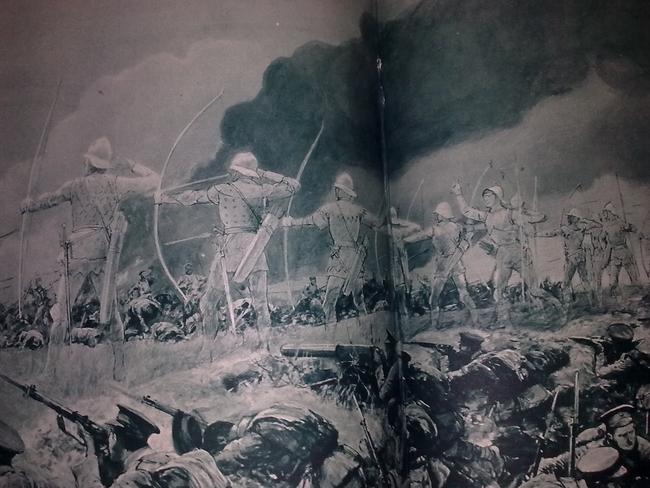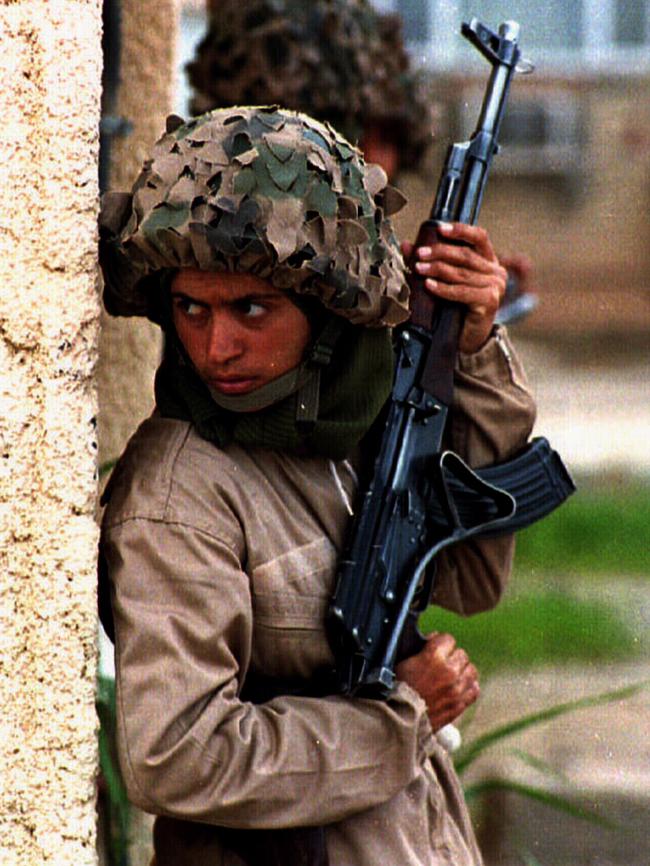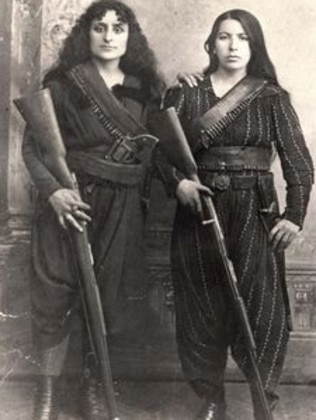Half-naked, camouflaged women snipers stalked the Anzacs at Gallipoli. More than a myth?
THEY hid in trees to pick off stragglers — and soldiers reported killing and capturing them. But did the mysterious women snipers of Gallipoli actually exist?
ANZAC Centenary
Don't miss out on the headlines from ANZAC Centenary. Followed categories will be added to My News.
ALMOST naked, her body painted camouflage green, she picked off Allied soldiers from a concealed firing post in the trees — until she was caught and slain by vengeful Australians.
Fully clad in traditional peasant garb, she gunned down unwitting foreign invaders from the windows of her white house, then crept out to plunder their bodies.

The story of the female sniper(s) of Gallipoli is an extraordinary one. The woman at the centre of it achieved mythical status among the Anzacs and Brits.
A lot of experts reckon she was just that — a myth. But sorting the fact from fiction in this weird historical sidebar is fascinating — especially when you can talk directly to the lads in the trenches about snipers, Turks and more at AnzacLive (or click on the Facebook grabs below).
WHO WERE THE MARKSWOMEN?
A number of soldiers’ tales from Gallipoli mention women snipers, operating singly and in groups, in various places. But there are no official reports.
The woman firing from her house — said to have been found with the identity tags of 16 of her victims — first appears in an account of April 25th, as the Brits attack W Beach at Cape Helles in the south of the peninsula.

The Times ran a story in July 1915, citing a wounded English seaman: “This sailor witnessed the capture of a woman sharpshooter in a little white house near the shore. She was a Turkish woman, and the house was her own. She had refused to leave it: Her old mother and her child were with her when she was taken. She had persistently fired on our men from a window, aiming in particular at the officers. She must have rifled the bodies of her victims, for some 16 identification discs and a considerable sum of money were found in her possession.”
The woman and her white house also reappear in an account of action three months later and 35km away, at Suvla. This time she is identified as a Turk soldier’s wife, living with her mother and child, who specialises in picking off stragglers — and she gets shot.
To be fair, it’s not unusual in the fog of war for times and places to get muddled in recollection.
However history buffs have expended much energy in debating how unlikely it would be for the woman to have achieved 16 kills, unnoticed, in a war zone almost devoid of civilians (and be stupid enough to hoard their ID tags). You can see one such discussion here.
More tellingly, in an otherwise well-documented campaign where snipers preoccupied our forces there’s not a single official record of a female version. Not one. Nor a photo.
HALF-NAKED AND PAINTED GREEN
“The place is simply walking with snipers, and they paint themselves green. I have heard that some female snipers were captured. How true it is I don’t know.” Corporal Ronald Semmence
The same lack of official record applies to the green-painted women and girls repeatedly mentioned, lurking in foliage with their Turkish male counterparts (who were very real, and a deadly menace to the Allies). Like many a sensational social media story today the accounts repeat, recycle each other and clash without ever producing solid, traceable, first-person testimony. Names are changed, units are not identified properly… and despite the many photos and sketches taken and made at Gallipoli, don’t waste your time searching for a picture of the ladykillers.

ANGELS & A CRUCIFIED PRISONER: WW1 MYTHS vs PROPAGANDA
In some accounts analysed by The Australian Light Horse Studies Centre, Aussie soldiers kill the camouflaged woman sniper.
This anecdote by British Lieutenant-Colonel Frank Mills, in a letter written 15 years later, certainly shows the troops’ hatred for the hidden Turkish sharpshooters. But note his first six words — a familiar refrain...
“I did not actually see it, but was told on the best authority of one case, which shows how our men looked on snipers behind our lines. He was at last located, and some went out to the oak and mad him come down. To their surprise he had a girl with him. She spoke a little English. They bayonetted the man at once, but the girl said: ‘Ah, but you English do not kill women.’ The men were so infuriated at the loss of their pals, that one of them said ‘don’t we’ and put his bayonet through her. She also had been sniping, and had a rifle, and knowing the state the men were in, awful as it may seem, one can perhaps understand it.”
In another uncorroborated version she is tied down and raped by Irish soldiers.
There is even a version, as usual lacking detail, that talks about several woman snipers being blasted out of the trees — and one half-nude markswoman who was found by Kiwis, set up with a machine-gun in a dugout. Historians have already pulled that apart as “pure fantasy” for a number of reasons, so we won’t bother here.
One crucial detail that has been addressed by Turkish experts is that the overwhelmingly Islamic Ottoman society of the time would not have allowed for women to join the military. That has changed enormously in the past 100 years, with female fighters in many Muslim and non-Muslim military and militia forces.
“You can strike out the possibility of women snipers, “ says Gallipoli documentary producer Tolga Ornek, in a book by John Hamiton on Australia’s famous markman Billy Sing.
“They are not mentioned in any official Turkish document and it would by very much against the Turkish social structure of the day. In no way would they have allowed a woman to come to the front lines — or the support lines for that matter.”
It is interesting but inconsequential in this context that some women did fight with Armenian groups who were locked into a desperate struggle against genocidal Ottoman forces even as the Anzacs struggled against the Ottomans at Gallipoli.


Of course a rogue or psychologically disturbed civilian (such as our lady of the white house) might have disobeyed religion and convention — but would not have been recruited or supplied by the army.
Most civilians were evacuated or fled the combat zones of Gallipoli, and many of them were ethnic Greeks who had tense relations with the Turks — which would have made them still less likely to fight a risky, one-woman war against the Allies, although it’s not impossible.
So if the female snipers didn’t exist; if they are, to quote Australian War Memorial historian Ashley Ekins “true furphies”, where did the stories originate?
RUMOUR BECOMES ‘REALITY’
There are two likely options.
Firstly... it is possible some of the few civilians who remained (by accident or design) in the battle zone may have been caught plundering dead bodies. That is a practice as old as war itself — and throughout history poor, desperate women and children have been just as likely as their menfolk to raid corpses.
As historian Michael McKernan told AnzacLive, “on a battlefield there are all sorts of rumours and stories”.
He adds: “With snipers everywhere in the first weeks of the campaign it was always hard to say why a particular man had been killed. A man might just fall with a bullet wound, hit randomly, or deliberately by a sniper, or accidentally by one of his own, firing at something else. Some Australians, of course, must have been shot by their own side, accidentally.”
So take an unexplained death; add a civilian found nearby with plunder, or even a weapon; mix it up with trench gossip and you have a gripping story that gets twisted and amplified as it is passed from dugout to dugout, up and down the peninsula — until we are left with unseen death squads of half-nude Amazons prowling the hillsides.
Yarn-spinning was vital to the men in making their “reality” less grim — periods of boredom alleviated only by terror and loss in squalid conditions with little comfort. And just like anyone today, many would be likely to spice up their tales with the unusual, controversial stuff.
Secondly… it was simply made up, Full Stop. One overactive imagination or even a jest taken as fact — feed it into the rumour-mill described above and watch the story take shape.
Interestingly, McKernan points out that “in Australian literature and Australian bush legend there is a long tradition of women passing themselves off as men. Maybe the sniper story depends to some extent on that tradition.”
Maybe.
We will probably never know for sure.
Originally published as Half-naked, camouflaged women snipers stalked the Anzacs at Gallipoli. More than a myth?


